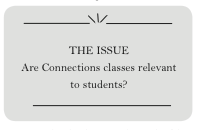Every other Wednesday, all students from freshmen to seniors visit their Connections classes and take part in various forms of what are supposed to be stress relieving exercises — well, that’s what they are supposed to do. Whether students take this twenty minute period to hang out with friends in the lounge, have a food party in their class, or truly take part in the activities, connections class is free for interpretation.
While a number of administrators worked with a school climate consultant to brainstorm activities to help students “build confidence to be [their]authentic self,” many students believe the activities are inauthentic. This maybe due to the predictable message of stress relief in the activities is challenged by the test or assignment that students are trying to cram in studying for because they view it as another mini free.
According to Principal Bill Egan, the original purpose of Connections was to provide every student with an adult, outside of a counselor or regular teacher, that they could establish a meaningful relationship with. This year, the Connections mission is to “cultivate a sense of calm across the NCHS community” and “develop awareness, attention and authentic practices that the entire school can use and rely on in times of stress.”
While many teachers stick to the activities to achieve those goals, teachers are also encouraged to do what suits the needs of their students. And while the work of all those people are admirable, the reality is most students still look at Connections as a waste of their time. According to Mr. Egan while the success of Connections depends on the deliverance from teachers in the activities, it also depends on the students’ willingness to buy in.
In order to get all students to truly buy in, the committee should consider a few on the following things: 1. Older students generally want more opportunities to have discussions. After a couple of years of highly structured lessons, students are able to see through the activities. 2. In order to succeed in the goal of reducing stress, connections can’t constantly be fighting against the piles of work students are faced with here. For students to be able to engage in those activities in Connections, they can’t be concerned with the lab they need to finish for period 7 or the test they have period 8.
Mr. Egan’s survey about the number of tests students’ face in a day is a step in the right direction and give an opportunity for students to voice their concerns. From asking these questions, students’ wellbeing is prioritized as well as give them another place to communicate.
To conclude, will connections seem more authentic if there are other areas of student life that become less stressful?



